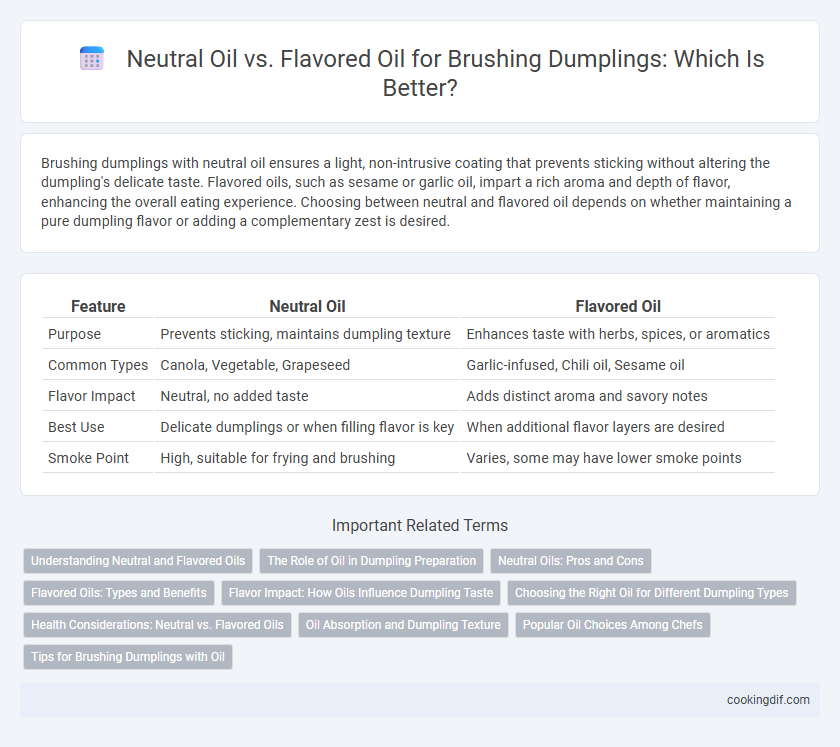Brushing dumplings with neutral oil ensures a light, non-intrusive coating that prevents sticking without altering the dumpling's delicate taste. Flavored oils, such as sesame or garlic oil, impart a rich aroma and depth of flavor, enhancing the overall eating experience. Choosing between neutral and flavored oil depends on whether maintaining a pure dumpling flavor or adding a complementary zest is desired.
Table of Comparison
| Feature | Neutral Oil | Flavored Oil |
|---|---|---|
| Purpose | Prevents sticking, maintains dumpling texture | Enhances taste with herbs, spices, or aromatics |
| Common Types | Canola, Vegetable, Grapeseed | Garlic-infused, Chili oil, Sesame oil |
| Flavor Impact | Neutral, no added taste | Adds distinct aroma and savory notes |
| Best Use | Delicate dumplings or when filling flavor is key | When additional flavor layers are desired |
| Smoke Point | High, suitable for frying and brushing | Varies, some may have lower smoke points |
Understanding Neutral and Flavored Oils
Neutral oils, such as vegetable or canola oil, have a mild flavor that won't interfere with the delicate taste of dumplings, making them ideal for brushing to prevent sticking and ensure a non-greasy finish. Flavored oils, like sesame or chili oil, add a distinct aroma and depth of flavor, enhancing the dumpling experience but should be used sparingly to avoid overpowering the filling. Understanding the subtle differences between neutral and flavored oils helps achieve the perfect balance between texture and taste in dumpling preparation.
The Role of Oil in Dumpling Preparation
Oil plays a crucial role in dumpling preparation by preventing sticking and enhancing texture. Neutral oil, such as vegetable or canola oil, is preferred for brushing dumplings due to its high smoke point and subtle flavor that doesn't interfere with the dumpling's taste. Flavored oils, like sesame or chili oil, add aromatic depth but should be used sparingly to avoid overpowering the delicate balance of fillings and wrappers.
Neutral Oils: Pros and Cons
Neutral oils like canola, vegetable, and grapeseed oil offer a high smoke point and subtle flavor, making them ideal for brushing dumplings to achieve a crisp texture without overpowering the filling. These oils provide consistency in cooking and allow the dumpling's natural flavors to shine, but may lack the aromatic depth that flavored oils like sesame or chili oil contribute. Choosing neutral oil ensures versatility and prevents flavor clashes, especially when serving a variety of dipping sauces alongside the dumplings.
Flavored Oils: Types and Benefits
Flavored oils such as sesame oil, chili oil, and garlic-infused oil enhance dumplings by adding depth and aromatic complexity that neutral oils lack. Sesame oil contributes a nutty richness ideal for dipping sauces or brushing before steaming, while chili oil introduces a spicy kick that elevates the overall taste profile. Using flavored oils not only improves the sensory experience but can also offer health benefits from natural antioxidants and anti-inflammatory compounds found in ingredients like garlic and chili peppers.
Flavor Impact: How Oils Influence Dumpling Taste
Neutral oils like canola or vegetable oil provide a subtle, clean base that lets the dumpling's filling flavors shine without interference. Flavored oils such as sesame or chili oil impart distinctive tastes and aromas, enhancing the overall sensory experience by adding depth and complexity. Choosing between neutral and flavored oil significantly influences the final flavor profile and can either highlight or transform the dumpling's natural ingredients.
Choosing the Right Oil for Different Dumpling Types
Neutral oils like vegetable or canola oil are ideal for brushing steamed or boiled dumplings, preserving their natural flavors without overpowering the filling. Flavored oils such as sesame or chili oil enhance pan-fried or baked dumplings by adding rich aromas and a spicy or nutty twist. Selecting the right oil complements dumpling texture and taste, elevating the overall eating experience for each type.
Health Considerations: Neutral vs. Flavored Oils
Neutral oils like canola and avocado provide a higher smoke point and contain healthy monounsaturated fats, making them ideal for brushing dumplings without overpowering the flavor. Flavored oils such as sesame or chili offer distinct taste profiles but may contain lower smoke points and added compounds that can oxidize at high heat, potentially affecting health. Choosing neutral oils supports a balanced nutritional profile and reduces the risk of harmful oxidation during cooking.
Oil Absorption and Dumpling Texture
Neutral oils like vegetable or canola oil absorb less into dumpling wrappers, preserving a light, tender texture ideal for steaming or pan-frying. Flavored oils, such as sesame or chili oil, tend to increase oil absorption, adding both moisture and a rich, aromatic taste that enhances the dumpling's surface crispness and overall mouthfeel. Optimizing oil choice affects dumpling texture by balancing oil retention with flavor infusion, ensuring a satisfying bite without greasiness.
Popular Oil Choices Among Chefs
Neutral oils like vegetable and canola are popular among chefs for brushing dumplings due to their high smoke points and subtle flavors that do not overpower the filling. Flavored oils such as sesame or chili oil are favored for adding an aromatic touch and boosting the overall taste profile while enhancing the visual appeal with a glossy finish. Many professional kitchens balance these options, choosing neutral oils for cooking and flavored oils for finishing to achieve optimal flavor and texture.
Tips for Brushing Dumplings with Oil
Use neutral oils like vegetable or canola oil for brushing dumplings to ensure even cooking without overpowering their natural flavors. Flavored oils such as sesame or chili oil provide a rich aroma and enhance taste, but should be applied sparingly to avoid masking delicate fillings. For best results, brush a thin layer of oil evenly on dumpling surfaces to achieve a crispy, golden texture during pan-frying.
Neutral oil vs Flavored oil for brushing Infographic

 cookingdif.com
cookingdif.com